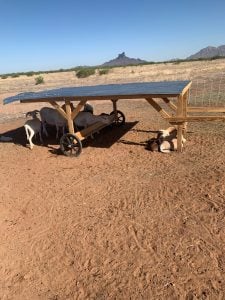|
Going against the grain
Aguirre spent more than a decade of his civil engineering career utilizing modern methods of stormwater management. His textbooks and his degree from University of Illinois taught him to manage water with a pipe, a channel and a hole in the ground. He described his career as “intrinsically connected to the land,” and that connection, along with his agrarian roots, led to much deliberation in the back of his mind. He felt a responsibility to leave the land he worked with better than he found it.
In August 2010, he became a father, and those deliberations moved to the front of his mind.
Aguirre imagined a conversation 15 years in the future in which his son asks whether he took advantage of being in a position to do something about the degrading environment.
“Looking at the designs that I had, that are now constructed, and the impact that they have on the environment,” Aguirre said, “I didn t like the answers that I was giving for that conversation with my son.”
Aguirre relegated his textbook knowledge and looked to a different teacher: Mother Nature. He studied how nature configured the water cycle, and how humans used to exist in and be part of the mineral cycles, eating and drinking off the land and returning the nutrients as wild animals do today, before the industrial revolution began in the 1700s.
“So through that discovery, I realized that we are going 180 degrees against the grain,” Aguirre said. “And the harder that we fight nature s principles, the more degradation that we re creating.”
In his research, Aguirre discovered holistic land management, which uses controlled grazing techniques to work cooperatively with ecosystem processes. It was pioneered by Allan Savory, founder of the Savory Institute, who grew up in South Africa loving the environment and despising livestock because he believed grazing damaged the land.
As a young biologist in Africa, he worked to set aside land to become national parks. In the 1950s, the protected land he studied in Zimbabwe continued to deteriorate, and he concluded there were too many elephants for the land to sustain. His superiors confirmed his research.
 A photo of a field before it was treated for desertification. (Photo courtesy of Grant Tims)
“Over the following years, we shot and killed 40,000 elephants to try to stop the damage,” Savory said in a 2013 TED Talk. “And it got worse, not better.”
He described it as “the saddest, and biggest blunder” of his life.
Savory was determined to find solutions. He traveled to the western U.S., where cattle had been removed from land to demonstrate how that would stop desertification. But he said he found the opposite.
Savory came to understand that the vegetation being lost in these expanding deserts was developed over thousands of years and adapted to large herds of grazing animals migrating across the landscape.
Aguirre is trying to address these same issues in the Southwest, explaining that land degradation has been caused by the lack of migratory animals brought on by urban expansion that reduces and limits animal populations.
When a fence goes up, said Grant Tims, Aguirre’s ranch manager, the land is left idle.
“So in arid climates, it’s the rest that is the problem,” Aguirre said, as Savory witnessed in Africa. “Where most people think it’s overgrazing.”
Aguirre relates “the health of the land to the health of the human body,” comparing land degradation to muscle atrophy in people: A sedentary lifestyle will cause the body to deteriorate.
“You re not stressing the land with hoof action, you re not stressing the land with animal impact,” he said. “That stress will actually cause a positive response.”
Aguirre reached out to the Savory Institute after the 2013 TED talk with a new concept of connecting civil engineering and holistic land management. In 2014, he went to Zimbabwe to see Savory’s work for himself.
Aguirre visited a small stream with big implications. The stream in recent decades had been ephemeral, meaning it only runs after rains, but villagers in the area had transformed the stream through holistic land management.
“For me, as a drainage engineer,” Aguirre said, “that just blew my mind that seven out of nine villagers that subscribed to this program were able to restore the watershed function to the degree that the streams were running again, on a perennial level, and reversed 40 years of an ephemeral stream.”
Shortly after, Aguirre became the director of his own Savory Hub in Arizona, which now is called the Drylands Alliance for Addressing Water Needs, where he teaches holistic land management practices. His goal is to transform his desertifying homeland, halfway between Phoenix and Tucson.
“That s … my personal BHAG (big hairy audacious goal) as a drainage engineer is to get that level of watershed function back into the watersheds of Arizona and the Southwest and beyond,” he said.
Aguirre took the idea of using land management instead of concrete and steel to address water resources to WEST Consultants, which welcomed the idea.
|